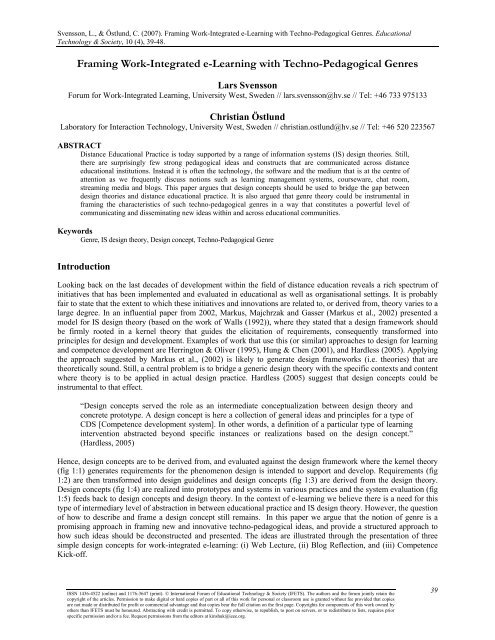October 2007 Volume 10 Number 4 - Educational Technology ...
October 2007 Volume 10 Number 4 - Educational Technology ...
October 2007 Volume 10 Number 4 - Educational Technology ...
Create successful ePaper yourself
Turn your PDF publications into a flip-book with our unique Google optimized e-Paper software.
Svensson, L., & Östlund, C. (<strong>2007</strong>). Framing Work-Integrated e-Learning with Techno-Pedagogical Genres. <strong>Educational</strong><br />
<strong>Technology</strong> & Society, <strong>10</strong> (4), 39-48.<br />
Framing Work-Integrated e-Learning with Techno-Pedagogical Genres<br />
Lars Svensson<br />
Forum for Work-Integrated Learning, University West, Sweden // lars.svensson@hv.se // Tel: +46 733 975133<br />
Christian Östlund<br />
Laboratory for Interaction <strong>Technology</strong>, University West, Sweden // christian.ostlund@hv.se // Tel: +46 520 223567<br />
ABSTRACT<br />
Distance <strong>Educational</strong> Practice is today supported by a range of information systems (IS) design theories. Still,<br />
there are surprisingly few strong pedagogical ideas and constructs that are communicated across distance<br />
educational institutions. Instead it is often the technology, the software and the medium that is at the centre of<br />
attention as we frequently discuss notions such as learning management systems, courseware, chat room,<br />
streaming media and blogs. This paper argues that design concepts should be used to bridge the gap between<br />
design theories and distance educational practice. It is also argued that genre theory could be instrumental in<br />
framing the characteristics of such techno-pedagogical genres in a way that constitutes a powerful level of<br />
communicating and disseminating new ideas within and across educational communities.<br />
Keywords<br />
Genre, IS design theory, Design concept, Techno-Pedagogical Genre<br />
Introduction<br />
Looking back on the last decades of development within the field of distance education reveals a rich spectrum of<br />
initiatives that has been implemented and evaluated in educational as well as organisational settings. It is probably<br />
fair to state that the extent to which these initiatives and innovations are related to, or derived from, theory varies to a<br />
large degree. In an influential paper from 2002, Markus, Majchrzak and Gasser (Markus et al., 2002) presented a<br />
model for IS design theory (based on the work of Walls (1992)), where they stated that a design framework should<br />
be firmly rooted in a kernel theory that guides the elicitation of requirements, consequently transformed into<br />
principles for design and development. Examples of work that use this (or similar) approaches to design for learning<br />
and competence development are Herrington & Oliver (1995), Hung & Chen (2001), and Hardless (2005). Applying<br />
the approach suggested by Markus et al., (2002) is likely to generate design frameworks (i.e. theories) that are<br />
theoretically sound. Still, a central problem is to bridge a generic design theory with the specific contexts and content<br />
where theory is to be applied in actual design practice. Hardless (2005) suggest that design concepts could be<br />
instrumental to that effect.<br />
“Design concepts served the role as an intermediate conceptualization between design theory and<br />
concrete prototype. A design concept is here a collection of general ideas and principles for a type of<br />
CDS [Competence development system]. In other words, a definition of a particular type of learning<br />
intervention abstracted beyond specific instances or realizations based on the design concept.”<br />
(Hardless, 2005)<br />
Hence, design concepts are to be derived from, and evaluated against the design framework where the kernel theory<br />
(fig 1:1) generates requirements for the phenomenon design is intended to support and develop. Requirements (fig<br />
1:2) are then transformed into design guidelines and design concepts (fig 1:3) are derived from the design theory.<br />
Design concepts (fig 1:4) are realized into prototypes and systems in various practices and the system evaluation (fig<br />
1:5) feeds back to design concepts and design theory. In the context of e-learning we believe there is a need for this<br />
type of intermediary level of abstraction in between educational practice and IS design theory. However, the question<br />
of how to describe and frame a design concept still remains. In this paper we argue that the notion of genre is a<br />
promising approach in framing new and innovative techno-pedagogical ideas, and provide a structured approach to<br />
how such ideas should be deconstructed and presented. The ideas are illustrated through the presentation of three<br />
simple design concepts for work-integrated e-learning: (i) Web Lecture, (ii) Blog Reflection, and (iii) Competence<br />
Kick-off.<br />
ISSN 1436-4522 (online) and 1176-3647 (print). © International Forum of <strong>Educational</strong> <strong>Technology</strong> & Society (IFETS). The authors and the forum jointly retain the<br />
copyright of the articles. Permission to make digital or hard copies of part or all of this work for personal or classroom use is granted without fee provided that copies<br />
are not made or distributed for profit or commercial advantage and that copies bear the full citation on the first page. Copyrights for components of this work owned by<br />
others than IFETS must be honoured. Abstracting with credit is permitted. To copy otherwise, to republish, to post on servers, or to redistribute to lists, requires prior<br />
specific permission and/or a fee. Request permissions from the editors at kinshuk@ieee.org.<br />
39

















